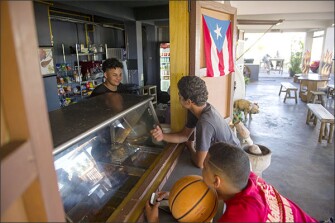
Before she left the Puerto Rico Department of Education earlier this month, then-secretary Julia Keleher said that one of the measures of success for the school system after Hurricane Maria will be how many high school graduates decide to stay on the island and take jobs there to contribute to the economy.
More than 18 months after the storm devastated Puerto Rico, it’s a fair concern—the public school system lost approximately 40,000 students between the last school year and this one, and the island’s finances remain very uncertain.
Beyond Puerto Rico’s struggles to recover after the storm, even basic data about its economy hasn’t been available. The Department of Commerce announced last month that for the first time, it will release statistics about Puerto Rican consumption and business investment that are taken for granted in other parts of the U.S.
According to World Bank data from the Federal Reserve Bank of St. Louis, the youth unemployment rate in Puerto Rico stood at 23 percent in 2017, the latest year of data available, compared to 9.2 percent for the U.S. (That number for Puerto Rico had actually been dropping for several years prior to Maria.) All of these and other factors will show whether Puerto Rico’s long-term decline in population continues, accelerates, or turns around in the wake of Maria.
So what efforts are underway or planned to help get students jobs after they graduate? There are a a few worth highlighting, from two different sources, but it’s also unclear whether they can—or should—work together in any particular way.
One has been launched by the American Federation of Teachers, whose local union affiliate in Puerto Rico is the Asociación de Maestros de Puerto Rico. The “Pathways to Prosperity” program is a model the AFT has previously supported in Peoria, Ill., along with its local affiliate. Through a searchable online platform, the program aims to connect Peoria-area industry with students looking for internships and other career-related opportunities. The Pathways initiative has also helped establish career centers at three local high schools. Since 2015, Pathways to Prosperity has helped 230 students score paid internships at 50 local employers, according to the AFT.
The union recently hosted a 15-person delegation from Puerto Rico to learn more about the initiative. Ultimately, the goal is for the initiative to create “several hundred internships at leading Puerto Rico businesses” by 2022, according to the AFT.
That would mark roughly five years since Maria. Puerto Rico’s public schools educate a little more than 300,000 students.
See Our In-Depth Coverage: Putting Puerto Rico’s Schools Back on Track
Then there’s a program Keleher helped to get off the ground late last year. She said she was inspired in part to address career-readiness when she talked to a Puerto Rico teenager who was trying to avoid drug dealing in his neighborhood, yet had been unable to find a job to focus his energy.
According to information released by the department, the schools system has helped secure 175 internships for students in areas such as plumbing and electrical work, as well as 200 jobs for high school graduates in various fields. Perhaps most significantly for the island’s ongoing recovery from the hurricane, the department says teachers have begun training to teach construction courses, so that eventually 2,100 students can get industry certifications to help them “contribute to the rebuilding of the island.” It’s not clear, however, whether those 2,100 students will have jobs waiting for them after graduation.
Separately, the island’s education department has established new partnerships with the telecommunications company Claro, the General Contractors Association of Puerto Rico, and others. In the 2019-20 school year, the island’s school system will for the first time provide career “exploratory” courses to students in middle schools. The department is also in the process of reviewing the system’s 14 career “clusters.”
We recently asked the AFT and Keleher about whether there’s any potential for them to join forces in this work. Weingarten said that despite interest from the union, it couldn’t work out an arrangement with Keleher and the education department to work together on career education efforts for students. Before she departed, Keleher, in turn, said she would be happy for the department to work with the unions on these efforts, but didn’t point to anything underway that could turn that idea into a reality.
Remember, Keleher and the Asociación de Maestros de Puerto Rico have fought vigorously for more than a year over prominent changes the ex-secretary initiated involving school choice.
Asked about the status of its initiative, a spokesman for the AFT said Tuesday: “There have been meetings with business leaders since the trip and we’re preparing to work with a partner to better understand the job landscape in Puerto Rico, which is something we’ve done at the outset on these projects in the past.”
Photo: High school student Tjeyder Manuel Díaz Vélez, left, works at his family’s restaurant in Manaubo, Puerto Rico, last year. Education leaders on the island are focused on connecting high school students to job training and work, but it remains to be seen how well they’ll coordinate separate efforts. (Swikar Patel/Education Week)
